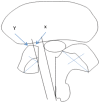The Morphometric Study of Degenerative Lateral Canal Stenosis at L4-L5 and L5-S1 Using Magnetic Resonance Imaging (MRI): Feasibility Analysis for Posterior Surgical Decompression
- PMID: 28435587
- PMCID: PMC5349339
- DOI: 10.5704/MOJ.1503.015
The Morphometric Study of Degenerative Lateral Canal Stenosis at L4-L5 and L5-S1 Using Magnetic Resonance Imaging (MRI): Feasibility Analysis for Posterior Surgical Decompression
Abstract
This study was to evaluate the morphological features of degenerative spinal stenosis and adequacy of lateral canal stenosis decompression via unilateral and bilateral laminectomy. Measurements of facet joint angulation (FJA), mid facet point (MFP), mid facet point distance (MFPD), the narrowest point of the lateral spinal canal (NPLC) and the narrowest point of the lateral spinal canal distance (NPLCD) were performed. At L4L5 of the right and left side, the mean distance between the lateral border of the dura and MFP was 1.0 ± 0.2 cm and 1.0 ± 0.3cm respectively. The mean NPLC was seen at 0.7 ± 0.3 and 0.7 ± 0.3 cm cm from the dura. At L5S1 of the right and left side, the mean distance between the lateral border of the dura and MFP was 1.2± 0.2 and 1.3 ± 0.2 cm respectively. The mean NPLC was seen at 0.8 ± 0.4 and 0.9 ± 0.5 cm from the dura. Unilateral laminectomy may result in incomplete decompression.
Figures






Similar articles
-
[Lateral fenestration combined with spinal canal decompression through contralateral laminotomy for radiculopathy caused by lumbar canal stenosis and lumbar foraminal stenosis: a case report].No Shinkei Geka. 2010 May;38(5):477-83. No Shinkei Geka. 2010. PMID: 20522920 Japanese.
-
Early Outcomes of Endoscopic Contralateral Foraminal and Lateral Recess Decompression via an Interlaminar Approach in Patients with Unilateral Radiculopathy from Unilateral Foraminal Stenosis.World Neurosurg. 2017 Dec;108:763-773. doi: 10.1016/j.wneu.2017.09.018. Epub 2017 Sep 12. World Neurosurg. 2017. PMID: 28919229
-
Microendoscopic lateral decompression for lumbar foraminal stenosis: a biomechanical study.J Spinal Disord Tech. 2014 Jul;27(5):257-62. doi: 10.1097/BSD.0b013e31828cff6e. J Spinal Disord Tech. 2014. PMID: 23563327
-
Sublaminar Decompression: A New Technique for Spinal Canal Decompression in the Treatment of Stenosis in Degenerative Spinal Conditions.Clin Spine Surg. 2017 Feb;30(1):14-19. doi: 10.1097/BSD.0000000000000452. Clin Spine Surg. 2017. PMID: 27775931 Review.
-
Radiographic evaluation of postoperative bone regrowth after microscopic bilateral decompression via a unilateral approach for degenerative lumbar spondylolisthesis.J Neurosurg Spine. 2013 May;18(5):472-8. doi: 10.3171/2013.2.SPINE12633. Epub 2013 Mar 22. J Neurosurg Spine. 2013. PMID: 23521685 Review.
References
-
- Jenis LG, An HS, Gordin R. Foraminal stenosis of the lumbar spine: a review of 65 surgical cases. Am J Orthop. 2001;30:205–211. (Belle MeadNJ) - PubMed
-
- Epstein NE, Epstein JA, Carras R, Hyman RA. Far lateral lumbar disc herniations and associated structural abnormalities. An evaluation in 60 patients of the comparative value of CT, MRI, and myelo-CT in diagnosis and management. Spine. 1990;15:534–539. (Phila Pa 1976) - PubMed
-
- Jenis LG, An HS. Spine update. Lumbar foraminal stenosis. Spine. 2000;25:389–394. (Phila Pa 1976) - PubMed
-
- Paksoy Y, Gormus N. Epidural venous plexus enlargements presenting with radiculopathy and back pain in patients with inferior vena cava obstruction or occlusion. Spine. 2004;29:2419–2424. (Phila Pa 1976) - PubMed
-
- Castro WH, Assheuer J, Schulitz KP. Haemodynamic changes in lumbar nerve root entrapment due to stenosis and/or herniated disc of the lumbar spinal canal--a magnetic resonance imaging study. Eur Spine J. 1995;4:220–225. - PubMed
LinkOut - more resources
Full Text Sources
